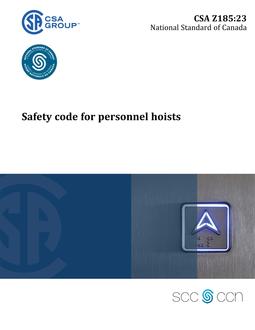CSA Z185:23
Preface
This is the fourth edition of CSA Z185, Safety code for personnel hoists . It supersedes the previous editions published in 1987, 1975, and 1972. Changes to this edition include the following: a) The Standard was updated to reflect changes in industry practice. Requirements related to the following technologies that are no longer in use were removed: i) winding drum drive machines; and ii) traction drive machines. b) Requirements for new technologies were added, including the following: i) electronic solid state devices; and ii) software technologies. CSA Group acknowledges that the development of this Standard was made possible, in part, by the financial support of AlumaSafway, Aylmer Construction Hoist, CKG Elevator Ltd., Les Produits Fraco Ltee., Hydro Mobile, MakHoist, Oxford Builders Supplies, PCL Constructors Inc., Tall Crane Equipment Limited, UCEL Inc., and YSB Hoist Inc. This Standard was prepared by the Technical Committee on Construction Hoists, under the jurisdiction of the Strategic Steering Committee on Mechanical Industrial Equipment Safety, and has been formally approved by the Technical Committee. This Standard has been developed in compliance with Standards Council of Canada requirements for National Standards of Canada. It has been published as a National Standard of Canada by CSA Group.
Scope
1.1 Inclusions
This Standard applies to structures and hoists that are not a permanent part of buildings, structures, or other works, and that are used during construction, alteration, or demolition to raise and lower persons and/or materials connected with or related to a building project. This Standard covers the design, construction, installation, maintenance, operation, and acceptance inspection and testing of personnel hoists.
1.2 Exclusions
This Standard does not apply to
a) hoists for raising and lowering materials with no provision for carrying personnel;
b) temporary elevators installed in their hoistways during the construction of buildings and incorporating a part of the permanent elevator to be installed later;
c) manlifts, counterbalanced or endless-belt type;
d) mine elevators;
e) cranes and derricks;
f) window cleaners and swing stages;
g) mobile fork lift trucks and similar equipment;
h) rope-guided and non-guided personnel construction hoists;
i) mast climbing transport platforms; or
j) mast climbing work platforms.
1.3 Terminology
In this Standard, “shall” is used to express a requirement, i.e., a provision that the user is obliged to satisfy in order to comply with the standard; “should” is used to express a recommendation or that which is advised but not required; and “may” is used to express an option or that which is permissible within the limits of the Standard. Notes accompanying clauses do not include requirements or alternative requirements; the purpose of a note accompanying a clause is to separate from the text explanatory or informative material. Notes to tables and figures are considered part of the table or figure and may be written as requirements. Annexes are designated normative (mandatory) or informative (non-mandatory) to define their application.
1.4 Units of measure
The values given in SI units are the units of record for the purposes of this Standard. The values given in parentheses are for information and comparison only.
Product Details
- Edition:
- 4th
- Published:
- 07/05/2023
- ISBN(s):
- 9781488347986
- Number of Pages:
- 77
- File Size:
- 1 file , 1.3 MB
- Product Code(s):
- 2430723, 2430723
- Note:
- This product is unavailable in Russia, Ukraine, Belarus
